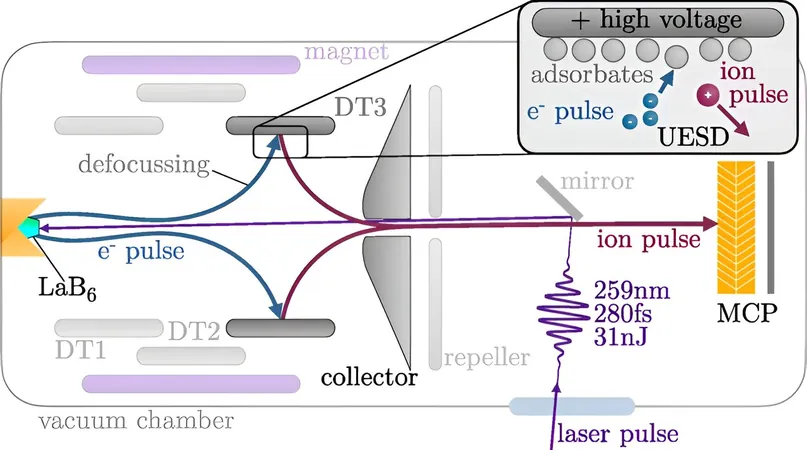
Breakthrough in Science: New Tech Creates Ultrafast Ion Pulses Revolutionizing Surface Analysis!
2024-09-17
Author: Jia
Introduction
Researchers at TU Wien in Vienna have achieved a monumental breakthrough by generating laser-synchronized ion pulses lasting less than 500 picoseconds. This groundbreaking technology opens up exciting possibilities for monitoring and analyzing chemical processes on material surfaces in real-time, as detailed in their latest publication in Physical Review Research.
The Need for Speed in Scientific Observation
In the quest to capture incredibly fast phenomena, scientists have long understood the necessity of tools with ultra-short response times. Just as a photographer needs a quick shutter speed to capture the fleeting moments of a fast-moving subject, researchers require equally rapid pulse technologies to visualize the fleeting processes occurring within and on the surfaces of materials.
Traditional Methods and Limitations
Traditionally, ion beams have played a crucial role in material science, aiding in the analysis, cleaning, and modification of various surfaces. However, prior methods primarily allowed analysts to observe the end results of interactions rather than the dynamic processes themselves. Professor Richard Wilhelm, from the Institute of Applied Physics at TU Wien, emphasizes the groundbreaking nature of this development: "Normally, you only ever get to see the end product... the exciting advancement here is generating ion pulses short enough to trace these processes in real time."
Exploring the New Ion Pulses
Lasting under 500 picoseconds—a duration that may seem inconceivable to the human experience—these ion pulses are a significant leap forward. For context, light travels just 15 centimeters in this minuscule timeframe. While today's shortest laser pulses exist on the attosecond scale (one quintillionth of a second), the new ion pulse timeframe strikes an optimal balance for detailed surface analysis.
The Mechanism Behind the Technology
The innovative approach involves a carefully orchestrated series of events: a laser pulse strikes a cathode, releasing electrons that are accelerated towards a stainless steel target. When these electrons collide with a layer of atoms—predominantly hydrogen and oxygen—some are dislodged, resulting in a mix of electrically neutral and ionized atoms. By harnessing electric fields, the team can selectively direct an ultrafast ion pulse onto the surface of interest, allowing for accurate analyses during ongoing reactions.
Precision and Control
"We can now control precisely when this pulse is generated and when it hits a surface," says Wilhelm. This precision means researchers can monitor changes occurring during a chemical reaction, shedding light on the intricate details of fast-paced interactions that were previously lost.
Exploring New Frontiers
Adding to the excitement, the technology is not limited to protons—scientists are looking to explore ion pulses made from other elements like carbon and oxygen, depending on the atoms chosen for the interaction. This flexibility paves the way for diverse applications across multiple fields of physics and chemistry.
Future Enhancements and Potential Impact
Future enhancements are already on the horizon, with plans to further reduce ion pulse durations through the use of specially designed alternating electromagnetic fields. "We have developed a promising new and astonishingly efficient technique for investigating ultrashort processes whose temporal dynamics could not previously be investigated," remarks Wilhelm.
Conclusion
This remarkable advancement, combined with existing ultrafast electron microscopy techniques, stands to revolutionize our understanding of surface chemistry and physics, unlocking new insights and applications across many scientific disciplines. The stage is set for a new era of atomic-scale exploration—scientists are eager to see what this powerful tool reveals next!




 Brasil (PT)
Brasil (PT)
 Canada (EN)
Canada (EN)
 Chile (ES)
Chile (ES)
 Česko (CS)
Česko (CS)
 대한민국 (KO)
대한민국 (KO)
 España (ES)
España (ES)
 France (FR)
France (FR)
 Hong Kong (EN)
Hong Kong (EN)
 Italia (IT)
Italia (IT)
 日本 (JA)
日本 (JA)
 Magyarország (HU)
Magyarország (HU)
 Norge (NO)
Norge (NO)
 Polska (PL)
Polska (PL)
 Schweiz (DE)
Schweiz (DE)
 Singapore (EN)
Singapore (EN)
 Sverige (SV)
Sverige (SV)
 Suomi (FI)
Suomi (FI)
 Türkiye (TR)
Türkiye (TR)
 الإمارات العربية المتحدة (AR)
الإمارات العربية المتحدة (AR)